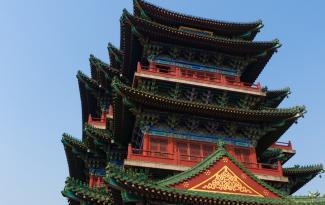
Last weekend I set off on my consistently untrustworthy bicycle to visit the Yuejiang Tower in the north of the Chinese city of Nanjing. I live in the South, in an extremely modern district for which the term ghost town rings hauntingly true. I had not researched the Tower before making my trip, although I knew that it was well-reputed for its views and atmosphere, and that it provided a pleasing contrast to an extremely modern, high-rise city. I had initially hoped that my trip would be something of a Road to Damascus revelation; an escape from the concrete artificiality which surrounded me and a rediscovery of a hidden Chinese past. There may be some truth in this perspective, but things turned out to be a lot more complicated than expected.
Every visitor to China is a slave to their idealization of what they naively believe to be the real China. In my case, as with many others, these preconceptions must involve an idyllic monastery-come-temple, adorned with Buddhist statues and located in the middle of nowhere (preferably near a mountain range). And most importantly, to my mind, this temple would be old – would, in fact, have stood since time immemorial – in order to emphasise the immense lifespan of Chinese culture. A lone Buddhist monk would preside over the monument, knowingly smiling to himself as the odd camera-happy Westerner fawned over its charm. This ideal would, as it turns out, thrust itself into my expectations and eventual perception of the Yuejiang Tower.
After a series of escapades involving near-crashes and an unfortunate disregard for traffic lights, I finally chanced upon the very thing I was looking for: what appeared to be an ancient traditional Chinese temple, triumphantly mounted on a hill. The tower itself. Here is the old, I told myself. This is the real China: the China that arrived before the West came marauding with its commercialism and its capitalism and its avalanche of multi-storey behemoths. Greenery abounded; trees outnumbered lampposts. The downtown towers were a distant memory.
Eventually I found my way to the top of the Yuejiang Tower. Whilst not quite in the middle of nowhere, and despite the lack of any Buddhist monk, the place seemed to satisfy a fair number of my ideals about the ‘real’ China. During my climb I encountered a number of attractions. Top of this list must come the lovesickness-carrying pavilion. A sign informed me of ‘fragrant grassland’ and told me to ‘cherish it please’. Having timed my ascent (in a moment of humiliating sentimentality) to coincide with the sunset, the views were astonishing. The Yangtze seemed to beckon the outside world – a world which so often seems infinitely distant in the claustrophobic centre of the city.. Finally, I told myself yet again, this is the real China.
Suddenly, my delusion was shattered. I stumbled upon a sign: construction of the temple began in 1999 and concluded in 2001. This tower, upon which I had briefly loaded my vision of an ancient China that yet defies the trespasses of modernity, is, it turns out, more modern than most of downtown’s concrete jungle. I was briefly dismayed. Then I realized something about my own idealization. I had been religiously searching out an old China of mostly my own invention.
In 1374 Zhu Yuanzhang (Emperor Hongwu) decided to build the Yuejiang Tower. He wrote a brief poem, but his dream did not materialize for over 600 years. Here is a encompassing portrait of the way we so often (quite literally) build castles in the air when it comes to engagement with the Chinese past. With what justification can we suggest that the tower bears any true resemblance to the long-buried imaginings of a culturally irretrievable empire? What difference does it make? There was nothing old here, even if a few poetic lines corresponded to the design. This was the New China; indeed, a China that may have been built to accommodate the kind of stereotypes that visitors like myself harbour. Even those quaint signs ... were they really comically poor mistranslations, or merely a pandering to the type of article this could have been? The Yuejiang Tower suddenly seemed as artificial and commercial as the neon pillars of downtown. But it worked. I tentatively returned to the view from the tower, no longer the sole bastion of antiquity in a sea of industry, and watched a sun setting not into the river directly below it, but into a thick layer of smog rising from the Yangtze’s docking towers. The nail in the coffin; even the sunset had been consumed, thwarted, perhaps, by industrialization and modernity. Funnily enough, it was probably the clearest sunset I’ve seen.
Have you ever visited a place that was nothing like you expected it to be? Tell us about your pleasant and unpleasant travelling surprises!
